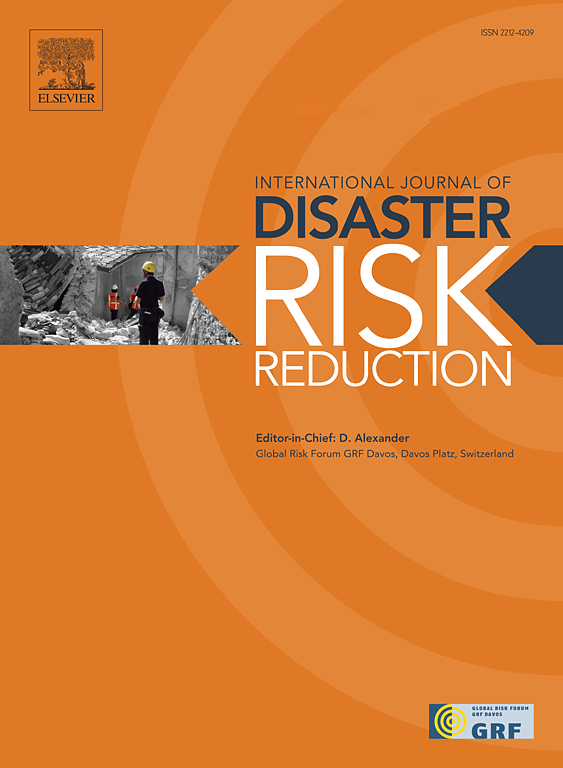灾后道路网紧急恢复规划的前瞻性战略
IF 4.2
1区 地球科学
Q1 GEOSCIENCES, MULTIDISCIPLINARY
International journal of disaster risk reduction
Pub Date : 2025-06-14
DOI:10.1016/j.ijdrr.2025.105648
引用次数: 0
摘要
灾后紧急恢复(ER)已成为提高关键基础设施系统(CISs)弹性的一种有前途的方法。然而,由于现代CISs的巨大状态空间,在现实世界的灾难发生后立即设计最佳的ER计划本身就具有挑战性。为了应对这一挑战,本文提出了一系列指导这些运动的战略,特别关注地震灾害下的道路网络(RNs)。最初,开发了一套基于启发式的、易于解释的策略。在先前研究的基础上,本研究探讨了前瞻搜索的集成,考察了其改进和适应这些启发式方法以满足ER活动的各种优化目标的潜力。为了实现这些策略,建立了一个基于多agent的模型(MABM),其中每个修复组都被建模为一个自治agent,并由所提出的规划策略指导。该模型的适用性通过其在灾难性地震场景下的真实RN中的实现来证明。各种策略的影响,对ER运动的有效性进行了审查和阐明。值得注意的是,将新开发的基于可达性的启发式方法与前瞻性相结合的规划策略,在依次平衡可达性和坍塌桥梁的临界性之间的权衡方面证明是有效的。案例研究结果表明,该方法在多种地震情景下均能满足不同的优化目标,可作为RNs震后应急响应的基准规划策略。本文章由计算机程序翻译,如有差异,请以英文原文为准。
Lookahead strategies for planning of post-disaster emergency restoration of road networks
Post-disaster emergency restoration (ER) has emerged as a promising approach to enhancing the resilience of critical infrastructure systems (CISs). However, devising optimal ER plans immediately after real-world disasters is inherently challenging due to the vast state space of modern CISs. To address this challenge, this paper proposes a range of strategies to guide these campaigns, with a particular focus on road networks (RNs) under earthquake disasters. Initially, a set of heuristic-based, easy-to-interpret strategies has been developed. Building on prior research, this study investigates the integration of lookahead search, examining its potential to refine and adapt these heuristics to meet diverse optimization objectives of ER campaigns. To operationalize these strategies, a multi-agent-based model (MABM) is established, wherein each restoration group is modelled as an autonomous agent, guided by the proposed planning strategies. The applicability of the model is demonstrated by its implementation in a real-world RN under catastrophic earthquake scenarios. The impact of various strategies on the effectiveness of the ER campaign is examined and elucidated. Notably, the planning strategy that combines a newly developed, accessibility-based heuristic with lookahead proves effective in sequentially balancing the trade-off between the accessibility and criticality of collapsed bridges. Based on the case study result, this approach consistently fulfils diverse optimization objectives across a range of earthquake scenarios, establishing it as the benchmark planning strategy of the post-shock ER of RNs.
求助全文
通过发布文献求助,成功后即可免费获取论文全文。
去求助
来源期刊

International journal of disaster risk reduction
GEOSCIENCES, MULTIDISCIPLINARYMETEOROLOGY-METEOROLOGY & ATMOSPHERIC SCIENCES
CiteScore
8.70
自引率
18.00%
发文量
688
审稿时长
79 days
期刊介绍:
The International Journal of Disaster Risk Reduction (IJDRR) is the journal for researchers, policymakers and practitioners across diverse disciplines: earth sciences and their implications; environmental sciences; engineering; urban studies; geography; and the social sciences. IJDRR publishes fundamental and applied research, critical reviews, policy papers and case studies with a particular focus on multi-disciplinary research that aims to reduce the impact of natural, technological, social and intentional disasters. IJDRR stimulates exchange of ideas and knowledge transfer on disaster research, mitigation, adaptation, prevention and risk reduction at all geographical scales: local, national and international.
Key topics:-
-multifaceted disaster and cascading disasters
-the development of disaster risk reduction strategies and techniques
-discussion and development of effective warning and educational systems for risk management at all levels
-disasters associated with climate change
-vulnerability analysis and vulnerability trends
-emerging risks
-resilience against disasters.
The journal particularly encourages papers that approach risk from a multi-disciplinary perspective.
 求助内容:
求助内容: 应助结果提醒方式:
应助结果提醒方式:


